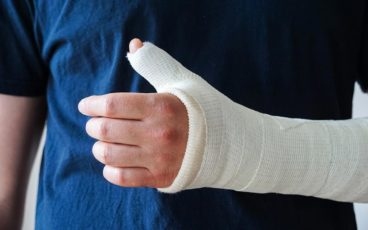The scaphoid is one of eight bones that form the complex part of the human body we know as the wrist. It is also the bone in the wrist that is most often injured, especially among athletes. Though not always easily noticed, a scaphoid fracture can have serious long-term consequences if not properly treated.
Function of Scaphoid
Located on the same side as the thumb, the scaphoid has an important function to those who play sports, and even to those who do not, by allowing the free movement of the wrist.
How Scaphoid Fractures Occur
Fractures of the bone can occur in virtually every athletic activity, although they often result from trauma that takes place in such direct contact sports as football and hockey. In other activities, such as biking or skating, a fracture can result from a fall. Even outside of sports, falling is commonly attributed to scaphoid injuries. Often, a person will attempt to use one or both hands to break a fall and as a result cause damage to the scaphoid.
Symptoms and Diagnosing
Scaphoid fractures are not always the same and, accordingly, have to be treated differently. Significant to this type of injury is that a simple fracture may not change the appearance of the wrist. The fracture will often be marked by pain, swelling and bruising in the area or pain associated with the movement of the thumb or the entire wrist. In an injury in which the bone is displaced, the break can usually be detected with an X-ray, although a simple fracture may require the use of MRI imaging or a CT scan to detect.
Treating Scaphoid Fractures
A simple scaphoid fracture will require a cast on the affected area that may extend as far as the elbow. The cast will have to remain in place for up to three months, during which time the person should be able to resume normal activities, including some athletic pursuits. However, participation in contact sports will have to be delayed.
A fracture in which the scaphoid is displaced or a simple fracture occurring near the end of the bone will require more rigorous medical attention, which may include surgery. Healing can be hampered by the fact that blood circulation in the area is limited. A displaced fracture that does not heal properly can result in prolonged pain and possibly in the death of the bone, which can itself lead to an arthritic condition.
If you are suffering from any of the previously mentioned symptoms or any wrist pain, contact an IBJI orthopedic physician for expert care.
*This content is for information only and is not intended to replace the diagnosis, treatment, or medical advice from your treating healthcare professionals. The content does not provide medical advice, does not constitute the practice of medicine or other healthcare professional services, and does not create a doctor-patient relationship. You should not rely on this information as a substitute, nor does it replace professional medical advice, diagnosis, or treatment. If you have concerns or questions, seek the advice of your healthcare professionals. If you think you may have a medical emergency, call your doctor or 911 immediately. Do not rely on electronic communications or communicate through this website for immediate, urgent medical needs. This website is not designed to facilitate medical emergencies. The use of the information is at the reader’s own risk. The links are provided for information and convenience only. We cannot accept responsibility for the sites linked or the information found here. A link does not imply an endorsement of a site.




